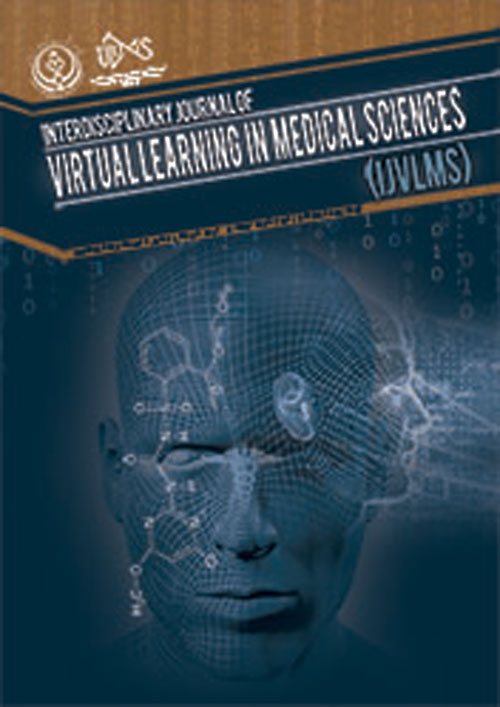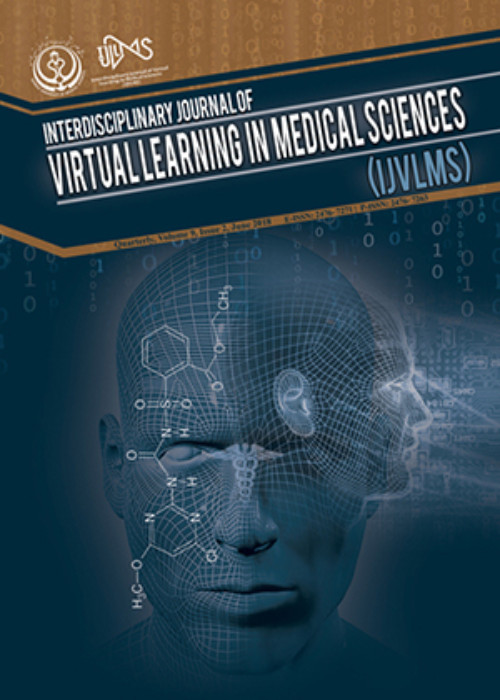فهرست مطالب

Interdisciplinary Journal of Virtual Learning in Medical Sciences
Volume:8 Issue: 3, Autumn 2017
- تاریخ انتشار: 1396/09/30
- تعداد عناوین: 7
-
-
Page 1BackgroundAccording to the connectivism learning theory, learning has a different form in the digital age compared to the industrial age, where traditional learning theories were applied. Thus, this study aimed at identifying and discovering implications of connectivism learning theory for distance education.MethodsThe present study was a qualitative research. Population of this study was all the documents that were published in Iran during 2007 and 2015. Based on this search, about 100 valid published academic materials including papers, books, websites, conferences, and other academic materials were recognized. Because of the large overlap of these materials, by using purposive sampling, 10 cases were selected as the research sample. In this study, Mayrings deductive qualitative content analysis method was used to extract implications of connectivism learning theory for distance education. According to the deductive model of qualitative content analysis, research question was identified in the first step. In the second step, valid and relevant publications and texts were determined. In the third step, aspects of theoretical analysis and categories were defined. In the fourth step, encoding of analysis units was done to infer the subcategories. In the fifth step, the main categories were extracted based on their most consistency with the subcategories; and in the final step, results were interpreted and quantitative assessment (e.g., frequencies) was done.ResultsThe results of this study referred to 9 connectivism implications as follow: networked teacher, networked students, networked learning, ecosystem, information and knowledge stream, connection and interaction, pluralism, and value measuring.ConclusionFindings of this study may be useful and helpful for instructional and learning designers in e-learning environments.Keywords: Learning Theory, Connectivism, Distance Education, Learning Implications, Learning
-
Page 2BackgroundThe present study aimed at investigating the designing dimensions of personalized e-learning environment scale based on intelligent agents and presentation of an integrated model from 11 intelligent agents.MethodsThis study was an applied research with respect to its nature and purpose, and a descriptive and survey research with regards to data collection methodology. The population of the study was 3 main groups: (1) professors in Payame Noor University (15 samples), (2) Ph.D. students in Payame Noor University of Tehran (48 samples), and (3) MA students of E-learning Center in Payame Noor University of Isfahan (112 samples) during the educational year of 2015 and 2016. To collect data, a researcher made questionnaire of personalized e-learning environment scale for intelligent agents was administered. Data were summarized and analyzed using Lisrel 8.5 software and SPSS 16 via descriptive indexes and inferential statistics. Using SPSS, the correlation coefficient between dependent and independent variables were measured, and the path analysis scale was performed to design a casual model, and finally the proposed fitting scale was measured using Lisrel software.ResultsResults revealed that among the components of personalized e-learning environment pattern based on intelligent agents, user and electronic content factors were, respectively, the most and least important in the proposed design.ConclusionsThe entire path of the research model was significant, which indicated a proper fitness of the proposed model to the real world data. Also, research hypotheses were approved, which means designing personalized e-learning environments by proposed intelligent agents increases the effectiveness of these courses.Keywords: Modeling, E, learning, Intelligent, Agents
-
Page 3BackgroundImplication of blended learning could compensate both the limitations of time and geographic distance presented in traditional classroom methods and deficiencies of class interaction and learners support that are peculiar to e-learning methods. To this aim, the present study was designed to examine and analyze the requirements for blended learning implications in higher education from faculty members point of view.MethodsThe study was conducted during spring of 2016 at the Semnan province Payam Noor branches. Participants in this study were 70 academic members of Semnan Payam Noor University, who were randomly selected by the Krejcie and Morgan formula from 85 faculty members. The data collection instrument was a newly developed questionnaire, the validity of which was determined by seeking views of 15 specialists in e-learning using the Delphi method. The reliability of the questionnaire was estimated through calculating internal consistency of items (α = 0.95). To analyze factors underlying specified requirements by the questionnaire, a factor analysis was conducted by the SPSS V.18 software.ResultsFactor analysis of academic members views resulted in 5 factors constituting infrastructure, political, professional, organizational, and instructional requirements. From academic members point of view, infrastructure requirements with nine loaded items were the most preliminary considerations for blended learning implication and accounted for 49.24% of the total variance. The second factor, political requirements, with six loaded items accounted for 7.75% of total variance. The third factor, professional requirements, with five loaded items, accounted for 6.29 of the total variance. The fourth factor, organizational requirements, with three loaded items and the fifth factor, instructional requirements, with two loaded items accounted for 4.61% and 4.34% of the total variance, respectively.ConclusionsThe findings showed that successful implementation of blended learning would result from considerations, such as allocation of sufficient funds and provision of necessary software/hardware facilities for blended learning in policies of universities and higher education institutions.Keywords: Blended Learning Implication, Blended Learning Requirements, Academic Member's Views
-
Page 4BackgroundManagement knowledge in the new centuryis, which is more important than anything when it comes to continuous change and development. Any organization that is not adapted with these waves is unsuccessful. The present study tries using the meta-synthesis method to design a comprehensive organizational e-learning model.MethodsThis study is a qualitative study, its method is heuristic, in terms of time it is sectional and in terms of purpose it is developmental and applied. This research method is a kind of meta-synthesis method that in order to implement the method, the 7 stage model of Sandelowski and Barroso (2007) was used. In this study, after designing research questions, a systematic search of databases of Persian and English papers, based on keywords related to organizational e-learning and all related and available papers, were collected and reviewed from 1992 to the end of 2015. In other words, to design the research model, no sampling was done; also in order to assess the content validity of the model, professors and experts opinions, in the field of e-learning, were used and to assess its reliability, Kappa indicator was used.ResultsAfter performing 7 stages of the meta-synthesis method and reviewing 324 articles in asystematic way, a model was designed with 12 groups (intellectual capital management, e-learning practices, learning facilitating factors, technical infrastructure, educational infrastructure, the people involved, individual factors, information, technical features, training, strategic management, and communication), 49 concepts, and 531 codes.ConclusionsAccording to the desired reliability and validity of the model designed based on professors and experts opinions, this model is recommended to recognize and plan e-learning system in organizations.Keywords: Meta, Synthesis, Organizational, E, Learning Model, Qualitative Study
-
Page 5BackgroundToday, one of the required skills for researchers successes is the optimal use of facilities and capabilities of cyberspace. The present study aimed at investigating the relationship between technological research skills and research self-efficacy of higher education students at Bu-Ali Sina University.MethodsThe population of this correlational research was all graduate students at Bu-Ali Sina University in the academic year of 2014 to 2015. Using Krejcie and Morgantable and applying stratified sampling, 329 subjects were chosen as participants of the study. Data were collected through a researcher-made questionnaire of technological research skills that was validated by 6 experts and with a reliability coefficient of 0.84, and the questionnaire of research self-efficacy was validated by Salehi et al. with a reliability of 0.84. The technological research skills questionnaire had 33 items and the research self-efficacy had 54 items. To analyze the data, Pearsons Correlation Coefficient and multiple regression was used with the SPSS 19 software.ResultsThe findings indicate that the level of technological research skills of the students was 2.71 with PConclusionsTechnological research skills could improve students research functions.Keywords: Higher Education, Research Self, Efficacy, Technological Research Skill
-
Ranking the Scientific-Technology Literacy Indexes of Students from the Viwepoint of Faculty MembersPage 6BackgroundIncreasing scientific-technology literacy is a major educational purpose around the world. This concept is an umbrella that covers everything related to science and knowledge. The aim of this research is its scientific ranking - technological literacy indicators of students from the viewpoint of faculty members of Islamic Azad University, Tabriz Unit.MethodsThe research method is descriptive and survey. The population consisted of all faculty members of the Islamic Azad University of Tabriz, which included 350 people in 2015. The sample size was estimated according to the Cochran formula. A total of, 186 individuals were selected by using the stratified random sampling. The measuring tool includes a Researcher questionnaire of scientific - IT literacy Miller (2006) (10 components and 40 questions); its validity was confirmed by experts and its reliability was assessed by using Cronbachs alpha coefficient to 0.81 values. Data were analyzed with SPSS 18 software.ResultsData analysis showed that the viewpoints of faculty members and scientific literacy indicators have a significant difference between the students (χ2 = 127.5; P = 0.00). The maximum rank was related to basic knowledge as well as foresight indexes and the lowest was related to the creativity index, however, no significant difference was found between the students for technology indexes (χ2 = 2.667; P = 0.264).ConclusionsThe students are in high rank in terms of basic and theoretical knowledge, which is a requisite for scientific literacy, however, in terms of creativity and curiosity, thinking manners (tendency to act) is ranked lower. Attention to critical thinking development and knowledge application in performance and real-life was recommended.Keywords: Scientific Literacy, Technological Literacy, Virtual University, Indexes, Students
-
Page 7BackgroundThe next generation of learning called mobile learning (m-learning) provides education to people through mobile devices. The security of mobile systems is an important issue due to users mobility and use of various devices and different ways of connecting to the network. Therefore, the current study aimed at providing a secure architecture as the basis for use in m-learning software to improve the security of such systems and investigate professors satisfaction with this architecture.MethodsThe current applied study was conducted in 2014. Statistical population included all professors using m-learning in Tabas, Firdaus, and Birjand cities, Southern Khorasan, Iran (26 participants). The purposive sampling method was used. The reliability of the questionnaire was measured using Cronbachs alpha (94%) and the validity based on factor validity (explained percentage of variance) was 63%. According to the use of the web-based e-learning service in Southern Khorasan Payam-e-Noor University (PNU), it was attempted to write a mobile application to provide the use of this service on mobile devices. The difference between the current study provided app and other mobile apps is based on using the proposed secure architecture. To measure the satisfaction of users with the study app, a researcher-made questionnaire was distributed among the professors using the app. Data analysis was performed with SPSS 16 by t test and the one-way analysis of variance (ANOVA).ResultsFindings showed that the professors using m-learning application of Southern Khorasan PNU had a positive attitude towards it with the average satisfaction of 80%. The most important factor for this satisfaction was the safety of the presented architecture, while avoiding complex and time-consuming control mechanisms.ConclusionsIn the current study a secure architecture was provided for mobile system that was simple, fast, and applicable on all mobile network operators. Given the positive perspectives of professors, this architecture can be a good solution to secure m-learning environments.Keywords: Learning, Distance Learning, Professor, Mobile Learning, Telecommunications, Data Security, Cryptography


